Shiyin Kang
Disambiguation of Chinese Polyphones in an End-to-End Framework with Semantic Features Extracted by Pre-trained BERT
Jan 02, 2025



Abstract:Grapheme-to-phoneme (G2P) conversion serves as an essential component in Chinese Mandarin text-to-speech (TTS) system, where polyphone disambiguation is the core issue. In this paper, we propose an end-to-end framework to predict the pronunciation of a polyphonic character, which accepts sentence containing polyphonic character as input in the form of Chinese character sequence without the necessity of any preprocessing. The proposed method consists of a pre-trained bidirectional encoder representations from Transformers (BERT) model and a neural network (NN) based classifier. The pre-trained BERT model extracts semantic features from a raw Chinese character sequence and the NN based classifier predicts the polyphonic character's pronunciation according to BERT output. In out experiments, we implemented three classifiers, a fully-connected network based classifier, a long short-term memory (LSTM) network based classifier and a Transformer block based classifier. The experimental results compared with the baseline approach based on LSTM demonstrate that, the pre-trained model extracts effective semantic features, which greatly enhances the performance of polyphone disambiguation. In addition, we also explored the impact of contextual information on polyphone disambiguation.
* Accepted at INTERSPEECH 2019
An End-to-End Approach for Chord-Conditioned Song Generation
Sep 10, 2024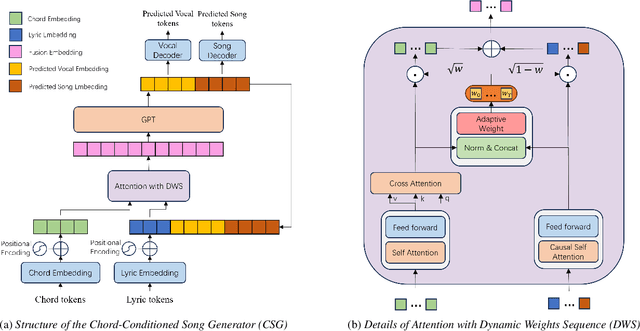

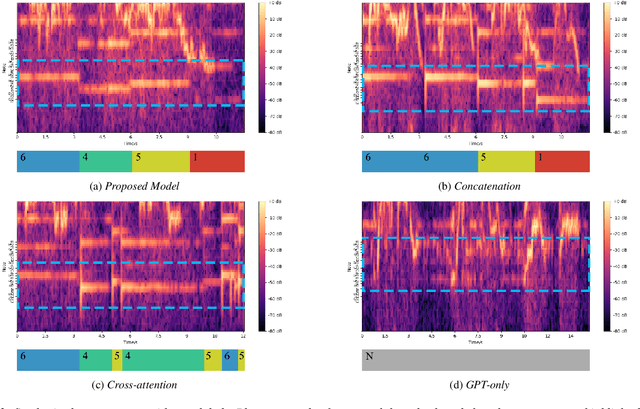
Abstract:The Song Generation task aims to synthesize music composed of vocals and accompaniment from given lyrics. While the existing method, Jukebox, has explored this task, its constrained control over the generations often leads to deficiency in music performance. To mitigate the issue, we introduce an important concept from music composition, namely chords, to song generation networks. Chords form the foundation of accompaniment and provide vocal melody with associated harmony. Given the inaccuracy of automatic chord extractors, we devise a robust cross-attention mechanism augmented with dynamic weight sequence to integrate extracted chord information into song generations and reduce frame-level flaws, and propose a novel model termed Chord-Conditioned Song Generator (CSG) based on it. Experimental evidence demonstrates our proposed method outperforms other approaches in terms of musical performance and control precision of generated songs.
SongCreator: Lyrics-based Universal Song Generation
Sep 09, 2024
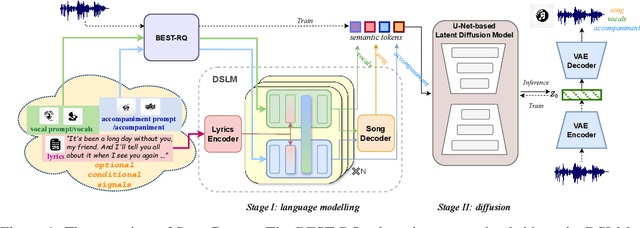
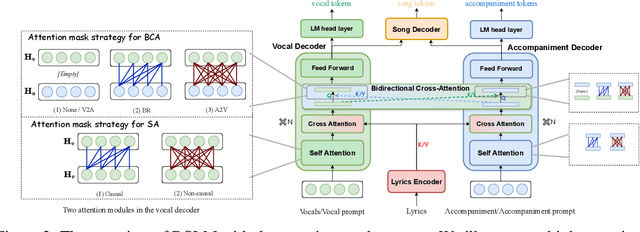

Abstract:Music is an integral part of human culture, embodying human intelligence and creativity, of which songs compose an essential part. While various aspects of song generation have been explored by previous works, such as singing voice, vocal composition and instrumental arrangement, etc., generating songs with both vocals and accompaniment given lyrics remains a significant challenge, hindering the application of music generation models in the real world. In this light, we propose SongCreator, a song-generation system designed to tackle this challenge. The model features two novel designs: a meticulously designed dual-sequence language model (DSLM) to capture the information of vocals and accompaniment for song generation, and an additional attention mask strategy for DSLM, which allows our model to understand, generate and edit songs, making it suitable for various song-related generation tasks. Extensive experiments demonstrate the effectiveness of SongCreator by achieving state-of-the-art or competitive performances on all eight tasks. Notably, it surpasses previous works by a large margin in lyrics-to-song and lyrics-to-vocals. Additionally, it is able to independently control the acoustic conditions of the vocals and accompaniment in the generated song through different prompts, exhibiting its potential applicability. Our samples are available at https://songcreator.github.io/.
Foundation Models for Music: A Survey
Aug 27, 2024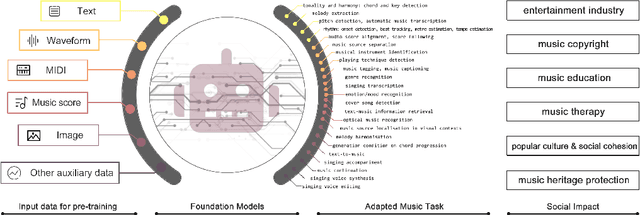
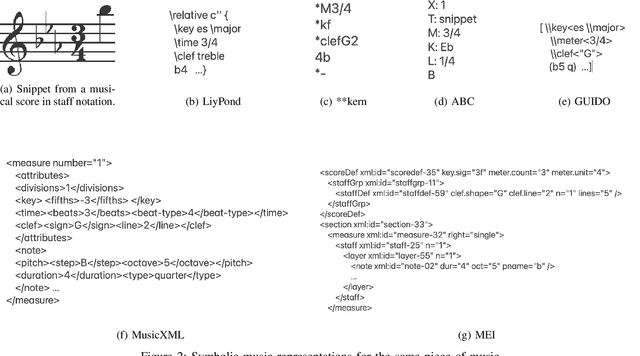
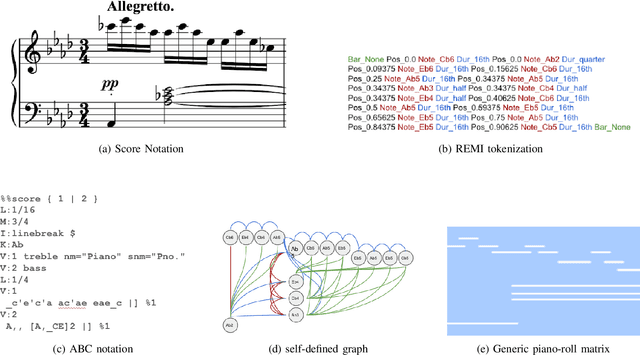
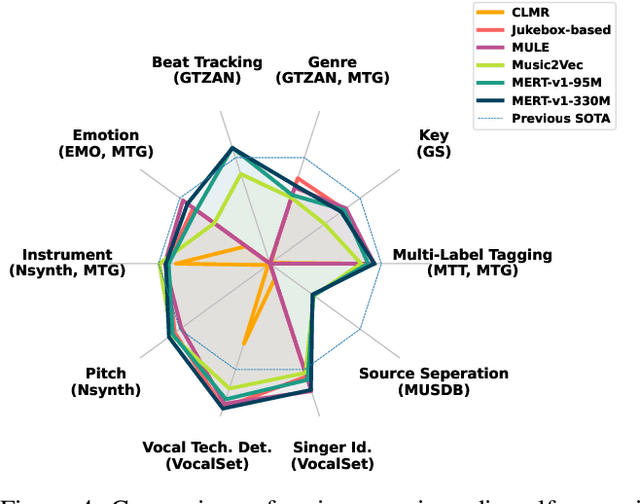
Abstract:In recent years, foundation models (FMs) such as large language models (LLMs) and latent diffusion models (LDMs) have profoundly impacted diverse sectors, including music. This comprehensive review examines state-of-the-art (SOTA) pre-trained models and foundation models in music, spanning from representation learning, generative learning and multimodal learning. We first contextualise the significance of music in various industries and trace the evolution of AI in music. By delineating the modalities targeted by foundation models, we discover many of the music representations are underexplored in FM development. Then, emphasis is placed on the lack of versatility of previous methods on diverse music applications, along with the potential of FMs in music understanding, generation and medical application. By comprehensively exploring the details of the model pre-training paradigm, architectural choices, tokenisation, finetuning methodologies and controllability, we emphasise the important topics that should have been well explored, like instruction tuning and in-context learning, scaling law and emergent ability, as well as long-sequence modelling etc. A dedicated section presents insights into music agents, accompanied by a thorough analysis of datasets and evaluations essential for pre-training and downstream tasks. Finally, by underscoring the vital importance of ethical considerations, we advocate that following research on FM for music should focus more on such issues as interpretability, transparency, human responsibility, and copyright issues. The paper offers insights into future challenges and trends on FMs for music, aiming to shape the trajectory of human-AI collaboration in the music realm.
ChatMusician: Understanding and Generating Music Intrinsically with LLM
Feb 25, 2024
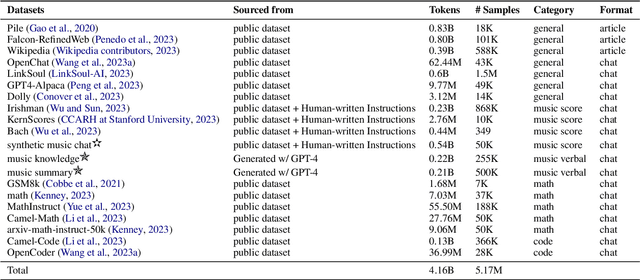


Abstract:While Large Language Models (LLMs) demonstrate impressive capabilities in text generation, we find that their ability has yet to be generalized to music, humanity's creative language. We introduce ChatMusician, an open-source LLM that integrates intrinsic musical abilities. It is based on continual pre-training and finetuning LLaMA2 on a text-compatible music representation, ABC notation, and the music is treated as a second language. ChatMusician can understand and generate music with a pure text tokenizer without any external multi-modal neural structures or tokenizers. Interestingly, endowing musical abilities does not harm language abilities, even achieving a slightly higher MMLU score. Our model is capable of composing well-structured, full-length music, conditioned on texts, chords, melodies, motifs, musical forms, etc, surpassing GPT-4 baseline. On our meticulously curated college-level music understanding benchmark, MusicTheoryBench, ChatMusician surpasses LLaMA2 and GPT-3.5 on zero-shot setting by a noticeable margin. Our work reveals that LLMs can be an excellent compressor for music, but there remains significant territory to be conquered. We release our 4B token music-language corpora MusicPile, the collected MusicTheoryBench, code, model and demo in GitHub.
SCNet: Sparse Compression Network for Music Source Separation
Jan 24, 2024



Abstract:Deep learning-based methods have made significant achievements in music source separation. However, obtaining good results while maintaining a low model complexity remains challenging in super wide-band music source separation. Previous works either overlook the differences in subbands or inadequately address the problem of information loss when generating subband features. In this paper, we propose SCNet, a novel frequency-domain network to explicitly split the spectrogram of the mixture into several subbands and introduce a sparsity-based encoder to model different frequency bands. We use a higher compression ratio on subbands with less information to improve the information density and focus on modeling subbands with more information. In this way, the separation performance can be significantly improved using lower computational consumption. Experiment results show that the proposed model achieves a signal to distortion ratio (SDR) of 9.0 dB on the MUSDB18-HQ dataset without using extra data, which outperforms state-of-the-art methods. Specifically, SCNet's CPU inference time is only 48% of HT Demucs, one of the previous state-of-the-art models.
Multi-view MidiVAE: Fusing Track- and Bar-view Representations for Long Multi-track Symbolic Music Generation
Jan 15, 2024



Abstract:Variational Autoencoders (VAEs) constitute a crucial component of neural symbolic music generation, among which some works have yielded outstanding results and attracted considerable attention. Nevertheless, previous VAEs still encounter issues with overly long feature sequences and generated results lack contextual coherence, thus the challenge of modeling long multi-track symbolic music still remains unaddressed. To this end, we propose Multi-view MidiVAE, as one of the pioneers in VAE methods that effectively model and generate long multi-track symbolic music. The Multi-view MidiVAE utilizes the two-dimensional (2-D) representation, OctupleMIDI, to capture relationships among notes while reducing the feature sequences length. Moreover, we focus on instrumental characteristics and harmony as well as global and local information about the musical composition by employing a hybrid variational encoding-decoding strategy to integrate both Track- and Bar-view MidiVAE features. Objective and subjective experimental results on the CocoChorales dataset demonstrate that, compared to the baseline, Multi-view MidiVAE exhibits significant improvements in terms of modeling long multi-track symbolic music.
AdaMesh: Personalized Facial Expressions and Head Poses for Speech-Driven 3D Facial Animation
Oct 11, 2023Abstract:Speech-driven 3D facial animation aims at generating facial movements that are synchronized with the driving speech, which has been widely explored recently. Existing works mostly neglect the person-specific talking style in generation, including facial expression and head pose styles. Several works intend to capture the personalities by fine-tuning modules. However, limited training data leads to the lack of vividness. In this work, we propose AdaMesh, a novel adaptive speech-driven facial animation approach, which learns the personalized talking style from a reference video of about 10 seconds and generates vivid facial expressions and head poses. Specifically, we propose mixture-of-low-rank adaptation (MoLoRA) to fine-tune the expression adapter, which efficiently captures the facial expression style. For the personalized pose style, we propose a pose adapter by building a discrete pose prior and retrieving the appropriate style embedding with a semantic-aware pose style matrix without fine-tuning. Extensive experimental results show that our approach outperforms state-of-the-art methods, preserves the talking style in the reference video, and generates vivid facial animation. The supplementary video and code will be available at https://adamesh.github.io.
Improving Language Model-Based Zero-Shot Text-to-Speech Synthesis with Multi-Scale Acoustic Prompts
Sep 22, 2023Abstract:Zero-shot text-to-speech (TTS) synthesis aims to clone any unseen speaker's voice without adaptation parameters. By quantizing speech waveform into discrete acoustic tokens and modeling these tokens with the language model, recent language model-based TTS models show zero-shot speaker adaptation capabilities with only a 3-second acoustic prompt of an unseen speaker. However, they are limited by the length of the acoustic prompt, which makes it difficult to clone personal speaking style. In this paper, we propose a novel zero-shot TTS model with the multi-scale acoustic prompts based on a neural codec language model VALL-E. A speaker-aware text encoder is proposed to learn the personal speaking style at the phoneme-level from the style prompt consisting of multiple sentences. Following that, a VALL-E based acoustic decoder is utilized to model the timbre from the timbre prompt at the frame-level and generate speech. The experimental results show that our proposed method outperforms baselines in terms of naturalness and speaker similarity, and can achieve better performance by scaling out to a longer style prompt.
Improving Mandarin Prosodic Structure Prediction with Multi-level Contextual Information
Aug 31, 2023



Abstract:For text-to-speech (TTS) synthesis, prosodic structure prediction (PSP) plays an important role in producing natural and intelligible speech. Although inter-utterance linguistic information can influence the speech interpretation of the target utterance, previous works on PSP mainly focus on utilizing intrautterance linguistic information of the current utterance only. This work proposes to use inter-utterance linguistic information to improve the performance of PSP. Multi-level contextual information, which includes both inter-utterance and intrautterance linguistic information, is extracted by a hierarchical encoder from character level, utterance level and discourse level of the input text. Then a multi-task learning (MTL) decoder predicts prosodic boundaries from multi-level contextual information. Objective evaluation results on two datasets show that our method achieves better F1 scores in predicting prosodic word (PW), prosodic phrase (PPH) and intonational phrase (IPH). It demonstrates the effectiveness of using multi-level contextual information for PSP. Subjective preference tests also indicate the naturalness of synthesized speeches are improved.
 Add to Chrome
Add to Chrome Add to Firefox
Add to Firefox Add to Edge
Add to Edge